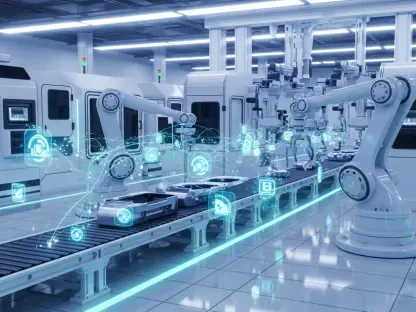In the fast-paced world of manufacturing, where every second of production counts toward profitability, unplanned downtime stands as a formidable adversary, draining resources and eroding trust with customers. Imagine a bustling factory floor grinding to a halt due to an unexpected equipment failure, costing millions in lost output and delayed orders within mere hours. This scenario is all too common, but a powerful solution is reshaping the industry: predictive technology. By harnessing real-time data, advanced analytics, and connected systems, manufacturers are now able to foresee potential breakdowns before they occur, transforming how maintenance is managed. This shift not only minimizes costly interruptions but also paves the way for smarter, more reliable operations. As the stakes of downtime continue to rise, understanding how predictive tools work to prevent disruptions offers a glimpse into the future of industrial efficiency and resilience.
The High Stakes of Downtime in Modern Factories
The financial toll of unplanned downtime in manufacturing is staggering, with Fortune 500 companies reportedly losing an estimated $1.4 trillion annually—roughly 11% of their revenue—due to unexpected production halts. In high-stakes industries like automotive manufacturing, a single hour of downtime can translate to losses of up to $2.3 million, or about $600 per second. These figures stem from missed production goals, idle labor, and delayed shipments, creating a ripple effect that impacts the entire supply chain. Beyond the immediate monetary damage, such disruptions often erode customer confidence, as delayed deliveries and unmet commitments strain business relationships. Traditional maintenance strategies, often based on fixed schedules or reactive repairs, frequently fail to address issues before they escalate, leaving factories vulnerable to preventable setbacks. This persistent challenge underscores the urgent need for innovative approaches to keep production lines running smoothly.
Moreover, the inefficiencies of outdated maintenance practices compound the problem, as rigid schedules may lead to unnecessary servicing of healthy equipment or overlook critical warning signs. Reactive repairs, initiated only after a failure occurs, often result in extended downtime while parts are sourced or complex fixes are implemented. The unpredictability of these breakdowns disrupts workflow planning, making it difficult for manufacturers to meet tight deadlines or adapt to market demands. Compounding the issue is the hidden cost of overworked staff, who must scramble to resolve issues under pressure, often leading to burnout or errors. As global competition intensifies, the inability to maintain consistent output can jeopardize a company’s market position. Addressing these systemic flaws requires a shift toward proactive solutions that anticipate problems rather than merely respond to them, setting the stage for transformative technologies to redefine operational stability.
Predictive Maintenance: A Game-Changing Approach
At the heart of reducing downtime lies predictive maintenance, a strategy that leverages real-time data from industrial IoT sensors embedded in machinery to monitor key indicators like vibration, temperature, and pressure. These sensors continuously feed information into AI-driven platforms, enabling manufacturers to predict equipment failures with remarkable accuracy. By identifying anomalies early, maintenance can be scheduled during planned downtimes, avoiding unexpected halts that cripple production. This data-centric approach marks a significant departure from traditional methods, as it focuses on prevention rather than reaction. Additionally, the integration of digital twins—virtual replicas of physical assets—enhances this process by allowing engineers to simulate scenarios and test solutions in a risk-free environment. Such tools provide insights into potential inefficiencies, ensuring that every maintenance decision is informed and strategic.
Beyond prediction, predictive maintenance extends the lifespan of equipment by addressing issues before they cause irreversible damage, ultimately reducing repair costs. The use of digital twins also creates a historical record of machine performance, which refines the accuracy of future forecasts over time. This continuous improvement loop helps manufacturers stay ahead of wear and tear, optimizing resource allocation. Statistics highlight the impact of this technology, with studies showing that predictive maintenance can cut unplanned downtime by up to 50%, boost maintenance productivity by 55%, and lower maintenance costs by 40%. These gains are not just theoretical; they translate into tangible benefits on the factory floor, where every avoided disruption preserves revenue and maintains customer trust. As IoT and AI technologies evolve, the precision and scope of predictive tools are set to expand, offering even greater potential to revolutionize how factories operate in a competitive landscape.
Real-Time Connectivity and Actionable Insights
Delivering actionable insights at the right moment is critical to minimizing downtime, and connected technologies are making this a reality on the factory floor. Wearable devices, such as smartwatches, serve as vital interfaces for technicians, providing instant access to alerts and diagnostic data without the need to return to a central control room. This immediacy accelerates response times, allowing issues to be addressed before they escalate into full-blown failures. Enhanced connectivity also streamlines communication between team members, ensuring that critical information reaches the right personnel swiftly. By integrating these tools with larger systems, manufacturers create a seamless flow of data that empowers workers to act decisively. The result is a more agile workforce capable of tackling challenges in real time, reducing the window of disruption and maintaining the rhythm of production.
A compelling example of this in action can be seen in the operations of a global automotive supplier managing over 300 facilities worldwide. At one high-volume plant producing millions of components annually, the transition from slow, manual issue reporting to a closed-loop alert system transformed efficiency. Using rugged tablets, smartwatches, and large-format displays, team leads could send immediate notifications to technicians’ wearables, slashing response times significantly. The system also provided analytics like mean time to repair (MTTR), enabling a shift from reactive fixes to proactive strategies. This real-world application demonstrates how connectivity not only resolves issues faster but also builds a foundation for continuous improvement. As more manufacturers adopt such integrated solutions, the ability to act on insights in real time becomes a cornerstone of operational excellence, driving reliability across global networks.
Building a Future of Intelligent Operations
The trend toward intelligent industrial operations powered by predictive technologies signals a profound shift in manufacturing paradigms, where reliability and profitability go hand in hand. Combining IoT sensors, AI analytics, and digital modeling, these tools offer a clear pathway to minimizing disruptions while maximizing output. The data speaks for itself: condition-based monitoring and predictive strategies have already proven their worth by delivering substantial reductions in downtime and maintenance expenses. Looking ahead, as these technologies become more sophisticated, their adoption is expected to grow, enabling factories to not only connect but also continuously refine their processes. This evolution promises a landscape where equipment failures are increasingly rare, and operational efficiency becomes the norm, positioning early adopters at a competitive advantage.
Reflecting on the strides made, it’s evident that the journey from reactive repairs to predictive solutions marked a turning point for the industry. Manufacturers who embraced real-time data and connected systems found themselves better equipped to handle the complexities of modern production demands. The success stories of those who implemented wearable tech and digital twins underscored the value of proactive thinking, as they saw significant drops in unplanned halts. Moving forward, the focus should be on scaling these innovations across smaller facilities and diverse sectors, ensuring broader access to their benefits. Exploring partnerships with technology providers to customize solutions for specific needs could further enhance outcomes. As the industry continues to evolve, staying committed to integrating predictive tools will be key to sustaining momentum, ultimately crafting a manufacturing future where downtime is a relic of the past.









